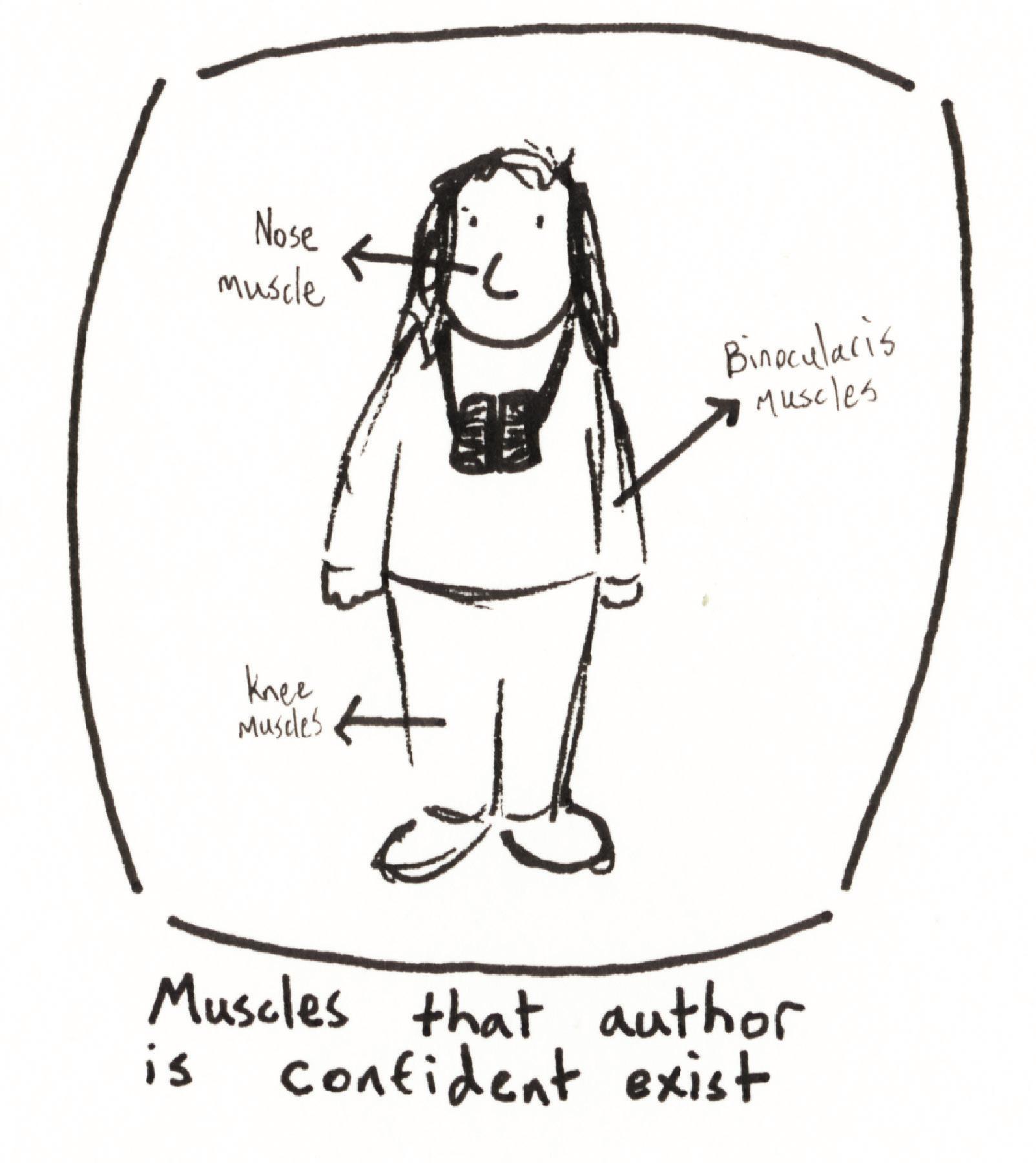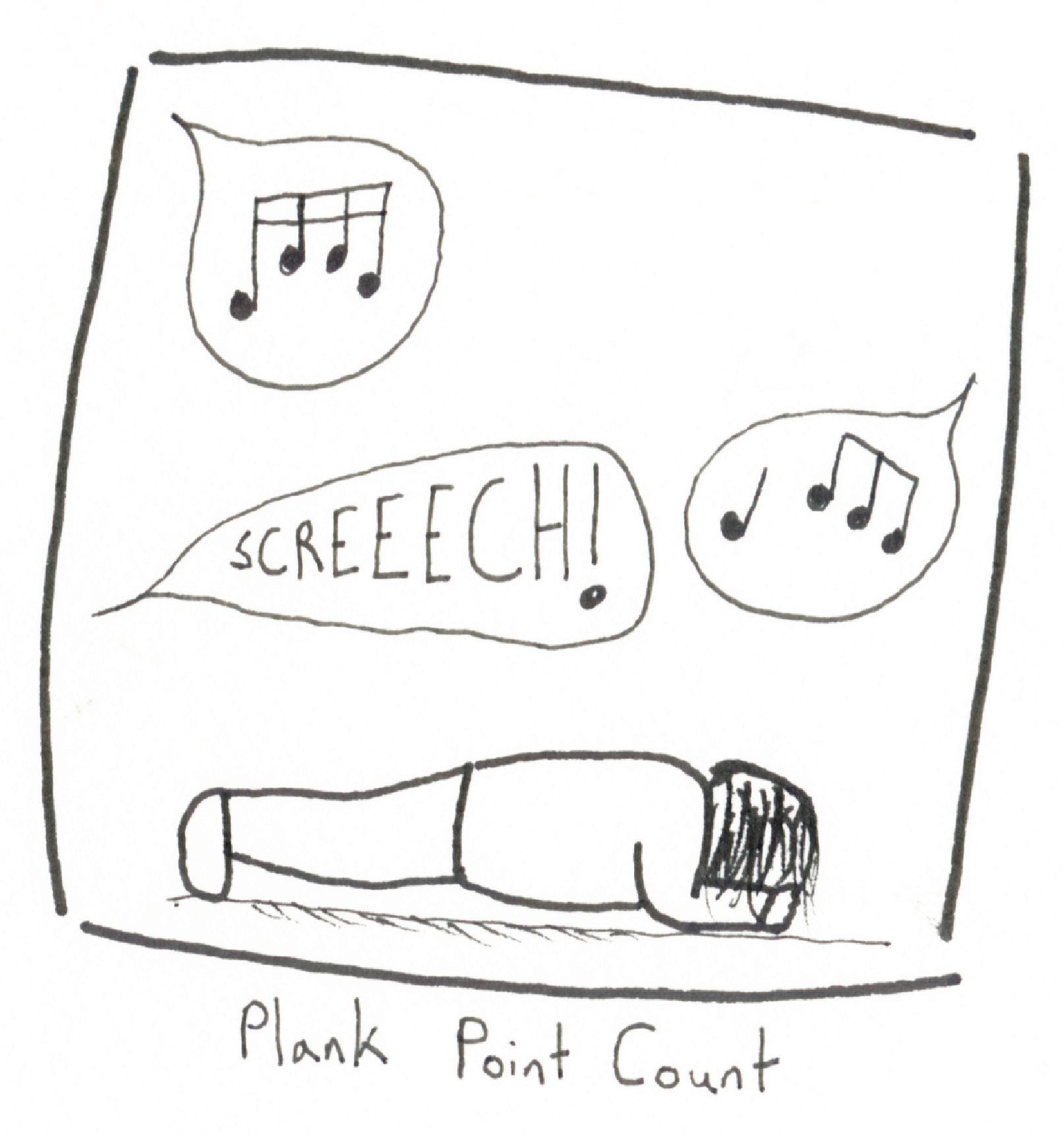
9 minute read
Five Ways of Strengthening Your Core While Looking at Birds
By Zach Phillips, Ph.D., Terrestrial Invertebrate Conservation Ecologist
Some people reach an intersection in life and choose a direction. Not me. I reach an intersection, and I lie down right there in the middle, traffic be damned. This happened recently when I was forced to choose between birdwatching (herein, “birding”) and doing core exercises. I decided not to choose, and out of that decisive non-choice this guide was born: The first guide in history to bring together birding and core exercises.
Who Is This Guide For?
It’s for anyone looking to expand their bird consciousness and strengthen their core. Which means everybody. That said, this guide is clearly for the birds.
What Inspired This Guide?
Before I hurt my back last year, I wasn’t aware of the scheduling conflict I’d face between birding and core exercises. In fact, I didn’t even know that “the core” existed. Sure, I’d heard rumors about a mysterious group of muscles that resided somewhere beneath my belly, but they were just rumors. Where was the evidence? Wasn’t “the core” just another Big Fitness conspiracy, as fake as “glutes” and “lats” and “biceps”? My physical therapist convinced me otherwise. He prescribed a series of core-strengthening exercises to help with my back recovery, and for whatever reason the exercises were most effective when I did them in the morning.
Unfortunately, morning is also the best time to survey birds, when many are at their most vocal and active. Nearly all of the bird surveys I conduct for research get me out of the house by 6 a.m., before I have time to finish strengthening my core. For the sake of my work and well-being, I had to find a way to fit both activities into my morning routine. Here was the intersection, and I needed to lie down in the middle of it. Eventually, I saw that there was only one solution: doing core exercises while birding (herein, “bird-core exercises”).

What Is in This Guide?
Birds aren’t easy to typecast — there are many reasons and ways to watch them. This guide describes five of those ways, from the standard to the weird. Our focus is therefore on modes and methods of bird observation, not species identification.
Each entry includes the following:
• A description of a mode of bird observation, supported by examples pulled from research, recreation, literature, and other sources.
• One corresponding bird-core exercise, ranked as “Easy,” “Difficult,” or “Super Difficult.”
• An artist’s detailed rendering of the exercise, or an aspect of the exercise, in action.
Do Not Attempt Any of the Following Bird-Core Exercises Without First Consulting a Medical Expert and a Bird Expert*
*Note: Consulting a veterinarian who specializes in the care of birds is not acceptable.
1. Point Count
The point count is a commonly used survey method for quantifying bird diversity. It does not involve pointing at birds, which is considered rude. An observer remains at a fixed point and identifies every bird they see or hear over a given period, often identifying more birds by their calls and songs than by visual cues. By using repeated point counts, you can estimate bird diversity and compare communities across space and time. For example, at Elings Park, Alice Keck Park Memorial Garden, and other sites where Santa Barbara Botanic Garden is conducting restoration, I’ve used repeated 15-minute point counts to compare bird communities in areas with restored native plant communities to those without.
Core Exercise (Difficult): Do a 15-minute point count from the plank position, one minute on, one minute off (but constantly birding). As a plank, you’ll be staring at the ground, which will not only test your core strength but will also test your ability to identify birds by sound.

2. Focal Follow
Point counts assess communities of birds, while focal follows spotlight individuals. The focal follower is like a private eye, tracking the movements and behavior of one bird, trying to see without being seen, and gathering as much dirt (i.e., data) on a bird as possible. What does the bird eat? Who does it interact with? Where and when does it sing? Is it having an affair?
Focal follows provide important, nuanced information about a bird’s activities. This information can flesh out life history accounts of species, contribute to building food webs and other ecosystem interaction networks, and help design effective management and conservation plans. At Elings Park, I conduct 10-minute focal follows to gather data on bird behavior in the Garden’s Landscape Transformation site, including on what plants birds interact with and the nature of those interactions, e.g., foraging in a coyote bush (Baccharis pilularis) versus perching on a coyote bush.
Beyond data, focal follows provide observers with a deeper appreciation for and connection to their subjects. A classic book that illustrates such a connection between birder and bird is J. A. Baker’s “The Peregrine.” The book is essentially a series of long focal follows conducted by the author, who obsessively tracks a couple of Peregrine Falcons (Falco peregrinus) across their hunting grounds in East Anglia, England. Many of J. A.’s observations represent interesting behavioral data, but they also indicate his growing, almost mystical, connection to the birds: “When mobbed, the peregrine beats its wings deeply and rhythmically. They bounce from the air, with silent slaps, like a lapwing’s. This deliberate pulse of evasion is beautiful to watch; one breathes in time to it; the effect is hypnotic” (Baker, 2005, 49).
Core Exercise (Easy): Find a lazy bird. I won’t name names, common or Latin, but you’ll know it when you see it. Locate a flat area near the bird, preferably with tall grass to conceal yourself, and lie down. Do three sets of 25 crunches while following it.

3. Be the Bird
Birds are vulnerable to “pishing” scams, which should not be confused with “phishing” scams. The latter is a human-to-human scam, with impostors sending out false information to trick their marks, while the former is a human-to-bird scam, with birders sending out false information to attract birds.
"Pishing” describes the birder behavior of making “pshh pshhhhh pshhh” noises — a ruse to draw birds closer for observation and identification. The “pish” noises apparently resemble alarm and begging calls, causing some birds to approach and join a “mob” to scare off the would-be predator. Of the modes of bird observation presented here, “pishing” is the most gonzo and participatory, with birders inserting themselves into the bird community through vocalizations.
Core Exercise (Difficult): Embarrassment is a very effective core strengthening emotion. To induce this feeling, find a public place crowded with people and trees. While staring into the canopy, loudly “pish” for one hour, experimenting with pitch, tone, and rhythm.

4. Wildlife Camera
These days, you can obsessively track a Peregrine Falcon from the comfort of your own home. Many universities and public institutions have set up “Falcon cams,” cameras that are focused on Peregrine Falcon nests, providing online video feeds that can be viewed 24/7. For about a decade, an incredible Anacapa Peregrine Falcon Cam has tracked a family of nesting Peregrines in their natural habitat. If J. A. Baker were still around, would he be watching? Would he post poetic, insightful comments on the Falcon Cam comment board? Or would he mostly complain about glitches in the live feed?
For research, wildlife camera traps are especially useful for recording bird behaviors and interactions over extended periods of time. For example, cameras trained on nests can record a variety of parentnestling interactions, including feeding interactions (e.g., what insects do parents feed nestlings?), which would otherwise be extremely difficult to observe. Camera traps, along with autonomous recording units (ARUs), that are used to record sound, can also be used to survey inconspicuous bird communities (e.g., nocturnal communities), and can record for periods that last much longer than a typical pointcount interval.
Core Exercise (Difficult): Go to Planet Fitness at 4:30 a.m. Ask a staff member if you can connect the Falcon Cam feed to the TV monitor that’s currently screening “Young Sheldon” reruns. If they say yes, watch the feed and do 10 squats while holding a 5-pound (2.3 kilograms) medicine ball. If they say no, pretend young Sheldon is some kind of bird, maybe a fledgling sparrow, and do 10 squats while holding a 5-pound (2.3 kilograms) medicine ball.

5. Birding at the Movies
Watching a movie can be treated like a two-hour point count. While remaining in your fixed position (i.e., your couch), conduct a bird survey. What birds do you hear and see on the screen? Often, the answer is “the wrong birds.” The sound design of a movie doesn’t usually prioritize geographically accurate bird calls and songs. Even the birds that make it on-screen are frequently misplaced, sometimes ending up on the wrong continent. A famous example are the Robins in “Mary Poppins,” a movie set in England. The Robins in the film are American Robins (Turdus migratorius), like we have here in the U.S., while they should probably be European Robins (Erithacus rubecula), a distantly related species (Hipperson, 2012).
: Get into a doctorate program that will let you write your thesis on birds in movies. Over the course of five to eight years, research and write a three-chapter dissertation on the cinematic history and symbolism of the American Robin and European Robin. Write chapter one about the European Robin that appears in “Gladiator,” a bird that General Maximus patiently observes in the film’s opening sequence. Explain how this scene establishes General Maximus as a birder of Rome first and a soldier of Rome second. Title this chapter, “Crowe meets Robin.” In chapter two, compare the symbolism of the three following American Robins: the artificial Robin in David Lynch’s “Blue Velvet,” the decaying Robin corpse in Stan Brakhage’s “Burial Path,” and the crime-fighting Robin depicted by Chris O’Donnell in “Batman Forever.” Title this chapter, “Batman and Robin and Robin and Robin.” Chapter three can be about whatever you want, but it better be good, and it better be about Robins. Graduate summa cum laude. Publish your dissertation as a leather-bound tome that weighs approximately 5 pounds (2.3 kilograms). Go to Planet Fitness at 4:30 in the morning. While holding your dissertation, do 10 squats. O

Acknowledgment: Thank you to my physical therapist, Jacob, for helping me believe in the core.
CITATIONS
Baker, J. A. (2005). The Peregrine. New York Review Books.
Hipperson, S. G. (2012, June 13). The Robin (and Mary Poppins). Stephen G Hipperson: My photography and other stuff. https://stephenhip.wordpress.com/2012/06/13/the-robinand-mary-poppins/










